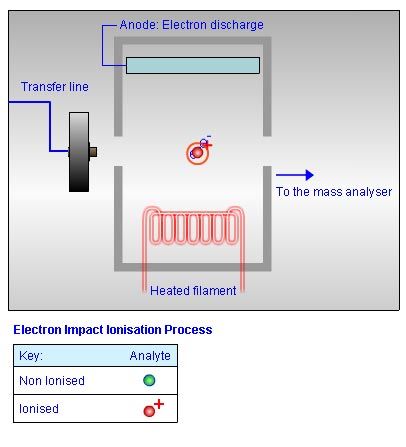Fundamentals of GC–MS Ionisation Techniques
Understanding how an instrument works is great, but when do you have time to read a textbook, or go to a course? Let CHROMacademy help. Dip in and out of concise modules and take 5 minutes to learn a little about the fundamentals of your analytical technique. Why not delve into GC-MS ionisation techniques right now?
Understanding how an instrument works is great, but when do you have time to read a textbook, or go to a course? Let CHROMacademy help. Dip in and out of concise modules and take 5 minutes to learn a little about the fundamentals of your analytical technique. Why not delve into GC-MS ionisation techniques right now?
Electron Impact (EI)
Electrons are emitted from a heated filament (usually made of tungsten or rhenium) and are accelerated across the source by using an appropriate potential (5 - 100 V) to achieve the required electron energy to ionise the molecule (Figure 1).
Figure 1: Electron impact ionisation process (See CHROMacademy.com for Flash video)

Figure 1: Electron impact ionisation process (See CHROMacademy.com for Flash video)
The analyte is introduced into the mass spectrometer ion source where it is impacted by the beam of ionising electrons leading to the formation of an analyte radical cation (Figure 2). The molecular ions produced can fragment by loss of a radical or of a molecule with all its electrons paired (Figure 3).
Figure 2: Formation of a cation radical and subsequent fragmentation to the molecular ion.

Figure 3: Formation of molecular fragments of butyl acetate.

EI is a relatively harsh form of ionization and as a result the parent often fragments further producing a pattern of fragment ions which can aid structural elucidation, however, the disadvantage of this is the frequent absence of the parent ion.
The complete article is available to CHROMacademy Lite and Premier members here >>
CHROMacademy Lite Membership is FREE and it only takes two minutes to register.
With a Lite Membership you are given access to:
- This month's webcast & tutorial
- Selected eLearning modules
- Featured CHROMacademy Content
- The CHROMacademy forum
Test drive CHROMacademy and Check out more great content available FREE to our Lite members »
Reversed Phase HPLC for the Analysis of Biomolecules
November 15th 2016Biopharmaceuticals offer great hope in treating medical conditions which are currently poorly served, at best, by traditional pharmaceuticals. It is estimated that there are over 400 biopharmaceuticals in clinical trials for in excess of 200 disease areas. The enhanced complexity and variability that comes from the size of biopharmaceuticals, allied with the intricacy of the production process, mean chromatography is employed to a much greater extent during production and release testing. The following article will introduce the fundamentals of biopharmaceutical analysis and cover the use of reversed phase HPLC in the analysis of biomolecules. A subsequent article will detail the application of HILIC, IEX, and SEC chromatography for the analysis if biomolecules.

